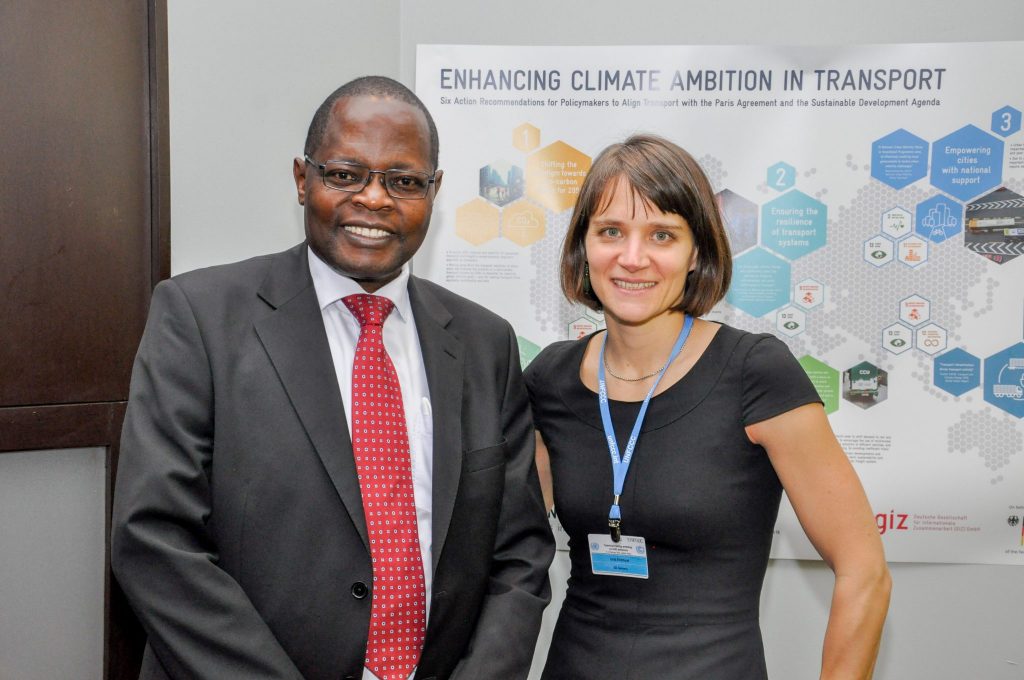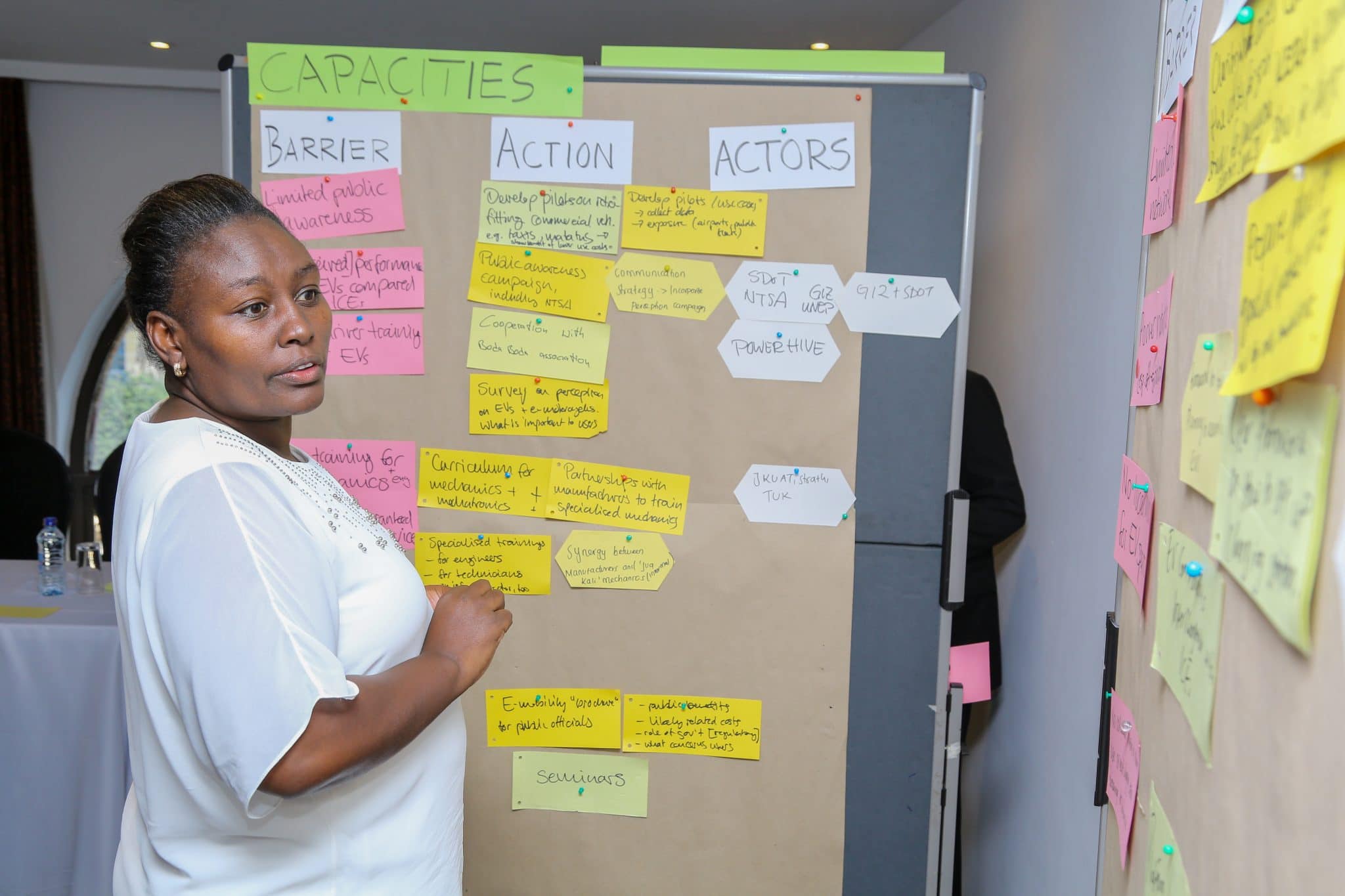
When the Advancing Transport Climate Strategies (TraCS) project started in 2017, the implementation of Kenya’s Climate Change Act was just getting started, and the transport sector was not yet a focus of climate change policy.
Martin Eshiwani, Director of Road and Rail Transport Services at the State Department of Transport (SDoT) and a key partner to the TraCS project provides a succinct overview Kenyan climate policy at the outset of the TraCS project in an interview available here.
TraCS Kenya aims to support the transport sector to align mobility and transport sector plans with climate plans, the so called NDCs. This is through improving data collection and assessment methods, identifying climate policy options, and monitoring emission reduction progress.
Kenya’s experience highlights a number of issues to keep in mind when designing and monitoring climate change strategies and action plans for the transport sector.
1. Training and assembling a climate change team
Training staff to understand the nexus between the transport sector, climate change, and data collection has been a key area of activity supported by TraCS, as highlighted in the interview with Mr. Eshiwani.
Kenya’s 2016 Climate Change Act requires every government department to set up a climate change unit (CCU). One major CCU activity has been to monitor carbon emissions and report on progress made regarding the implementation of climate change actions in each sector. To fulfil these responsibilities, CCU staff need to understand what types of data are required as well as how to gather and interpret them. To this end, TraCS hosted several practical training sessions over a period of two years that were attended by sector climate change focal points from SDoT and different state agencies. This knowledge sharing – in addition to the coordination of efforts encouraged by the training – has significantly facilitated the implementation of Kenya’s 2016 Climate Change Act.

With the support of TraCS project advisors, the climate change team for the transport sector was the first to submit a sectoral climate change report to the Climate Change Directorate of the Kenyan Ministry of Environment and Forestry.
2. Identifying the status quo
Kenya’s Nationally Determined Contribution (NDC) calls for emission reductions in the transport sector of 3.46 Mt CO2e by 2030. Five years have elapsed since this target was set, making it high time to take stock: Is the transport sector on track to achieve its 2030 target?
While 86.8% of the Kenyan power mix came from renewable sources in 2019, the transport sector still relies heavily on fossil fuels. In 2015, for example, the transport sector in Kenya accounted for 67% of energy-related CO2 emissions (Draft GHG inventory report, 2020). There was thus a pressing need to identify and implement mitigation actions throughout the sector.
However, before mitigation actions can be designed and implemented, it is crucial to gather primary data. In many countries, data gathering is often the most challenging task, as collection activities are often scattered among different agencies or are not performed on a systematic basis.
In Kenya, the process of data collection began with an assessment of the availability of relevant data and policies. After identifying potential data sources, emission profiles were developed for each transport sub-sector.
3. Missing data: Connecting the dots
To understand the distribution of transport sector emissions in more detail, researchers typically develop estimates using a “bottom–up” approach.
Bottom-up calculations are performed based on the activity data of the vehicle fleet in conjunction with emission factors per activity. Specifically, the average distances travelled annually in different vehicle categories are multiplied by an emissions factor based on the specific fuel consumption in those categories. This helps to identify the main emitters per subsector, e.g. heavy trucks, private cars, or motorcycles. The TraCS project focused on road transport emissions because it is the sub-sector with the largest share of transport emissions in Kenya.
Performing such calculations for Kenya proved tricky, however, due to data problems. For example, like many other developing countries, the Kenyan vehicle registry does not contain information on the active share of the vehicle fleet. This is because registered vehicles are not deregistered when they go out of use.
In addition, Kenya imports a large number of used vehicles, and odometer readings are thought to be frequently altered.
Due to a lack of reliable data on in-use vehicles, TraCS cooperated with the University of Nairobi to determine the size of Kenya’s in-service vehicle fleet. The study estimates the size of in-service fleet by vehicle category, while also providing information on age profiles and average annual mileage.
These data allowed road transport emissions in Kenya to be estimated and country-specific emissions factors could be developed for the very first time. The emission factors developed as part of this study are summarized here.
4. Linking the sector to the national climate action plans
The TraCS study on the size of Kenya’s fleet also provided a basis for developing climate protection scenarios.
Participating researchers and policymakers held discussions with stakeholders in the transport sector in order to explore mitigation options and also ensure policy coherence between sectors.
Building on these discussions, stakeholders defined priority mitigation actions during the deliberative process to update Kenya’s National Climate Change Action Plan (NCCAP) in 2018–2022. Promoting e-mobility was a key policy area added to the NCAAP, which is the primary tool for implementing Kenya’s NDC.
The TraCS project supported the recalculation of four identified mitigation actions as a basis for updating the NCCAP section on transport. The report that was produced advocated shifting transport demand from road to rail, improving the efficiency of passenger and heavy-freight vehicles, and expanding electrification.
With regard to planning in sector, the TraCS team also contributed to the revision of the Integrated National Transport Policy (INTP). The INTP now includes a climate change strategy and emission reduction targets, thus ensuring harmony with national climate change legislation. While the INTP is currently undergoing approval, as soon as it is adopted it will provide a springboard for the initiation of further plans and strategies in the transport sector.
5. Modifying tools to calculate emissions
In addition to supporting emissions data collection and assessment, the TraCS team supported Kenya’s GHG reporting process by adapting the Transport Inventory and Greenhouse Gas Emissions Reporting (TrIGGER) tool to the Kenyan context.
The TrIGGER tool is a simple bottom–up spreadsheet model used to calculate national transport greenhouse gas (GHG) inventories. The tool can be easily used by countries to develop a bottom–up emissions inventory, given the availability of required data. TraCS team members additionally collaborated with the core team that developed the GHG National Inventory Report (NIR) for Kenya. TraCS contributed to data and reporting related to the Kenyan energy sector, whose emission profile was developed using IPCC software.

6. Institutionalising the data collection process
While the TraCS project has achieved a number of successes, activities related to mitigation policy development and GHG reporting need to be sustained over the long term.
In order to support the continuation of the activities initiated by TraCS, the TraCS team has been working to establish an institutional framework for the climate-sector data collection process.
To this end, the first step was to perform an institutional assessment to establish the transport sector’s readiness for complying with the Enhanced Transparency Framework of the Paris Agreement and with national reporting requirements. The assessment identified areas for improvement, including further disaggregation of transport fuel consumption data in the national statistics system and the need for a single data collection template for the entire sector.
TraCS then supported the development of a data collection template for transport, which is currently being piloted to collect data on fuel consumption and policy implementation.
All of these activities have been accompanied by capacity development and a stakeholder dialogue to furnish a basis for data sharing and reporting among different transport agencies and the Kenya National Bureau of Statistics.
7. Resource allocation
Yet another crucial area of importance is resource allocation, both in terms of financial support and human resources. To be sure, robust monitoring, reporting, and strategy development is impossible in the absence of stable organizational structures that are outfitted with sufficient resources.
While securing adequate funds remains a challenge for the Kenyan climate change unit, the Kenyan experience highlights the importance of creating dedicated units to coordinate the mainstreaming of climate change policy in the strategic planning of each economic sector.
Although the COVID-19 pandemic has understandably taken centre stage at the moment, discussions on climate change remain a vibrant component of Kenya’s transport sector. Efforts are ongoing to map out opportunities compatible with funding constraints.
Over the last three years, the TraCS team has been proud to support Kenyan efforts to strengthen institutional frameworks for greater transparency in transport as well as greater alignment between national climate and transport policies. The TraCS project will leave a lasting mark: Kenya is now home to many individuals actively pushing for ambitious climate action in the sector, efforts that will continue in the years ahead.
Find out more about new developments here.
You are currently viewing a placeholder content from X. To access the actual content, click the button below. Please note that doing so will share data with third-party providers.
More Information